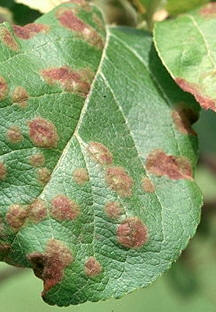Apple Scab

DESCRIPTION
Apple Scab is a serious disease of apple and ornamental crabapple. The disease favors wet, cool spring weather. Both leaves and fruit can be affected. The infected leaves may drop, resulting in an unsightly landscape and fruit production may be poor. Early defoliation can weaken the trees, making them more susceptible to winter injury or other pests. Infected fruits are blemished and often deformed. Infected fruit may also drop early.
SYMPTOMS
Symptoms first appear in the spring as spots on the lower leaf surface. Initially, the spots are small, velvety and olive green in color. On some crabapples, infections may be reddish in color. With time, the spots become darker and have a more distinct outline. If heavily infected, the leaf becomes distorted and drops in the early summer. Trees may be severely defoliated by mid to late summer.
Fruit symptoms are similar to the symptoms on the leaves. The lesions often become black and “scabby”. Badly infected fruit becomes deformed and may fall before reaching normal size.
CAUSAL ORGANISM
Apple Scab is caused by a fungus that survives winter in the previous years diseased leaves that lay under infected trees. In the spring, the fungus on the fallen leaves disperses millions of spores during rain periods in April, May and June. These spores are carried by the wind to young leaves, flower parts and fuits. These new lesions create more spores which are spread throughout the tree by splashing rain. This is why Apple Scab is more prevalent during years with frequent spring rains.
CONTROL
The ideal method of controlling Apple Scab is to plant immune varieties of trees. There are many varieties that are either highly resistant or immune to scab. You can also rake and destroy fallen leaves which will reduce the number of spores that can start the disease cycle in the spring. Where resistance to scab is not present, fungicide applications are the primary method of control.

